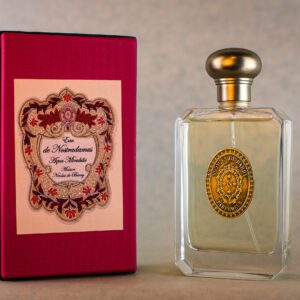Eau de Parfum – Marquise de Pompadour
Eau de Parfum – Marquise de Pompadour
Eau de Parfum – Marquise de Pompadour
The Iris flower dominates the head notes, and the bouquet gathers the marquise’s favourite flowers: Rose, Jasmine, Gardenia, Hyacinth, Daffodil, Carnation and Tuberose. The Iris and Amber in their persistent nature give a more powdered elegance to this bouquet.
In the whole of Europe, the court of Louis XV was nicknamed “the perfumed court”, to admire or stigmatise it… Indeed, the eighteenth century is the century of « enlightenment » but also of “perfumes” and globally of elegance… Perfumers such
as Fargeon and Dejean before him left us with precise treatises on the use of raw materials and the tastes of the century.
Historians report the King and Marquise’s passion for orange trees, flower bouquets, baths (the recent refurbishments of the Louis XV’s two-baths bathroom in Versailles illustrate this well), the potpourris etc. In Versailles, in the private and secret
apartments of the King, perfume is everywhere, so much that some authors highlight the stench of the common portions from which the King escapes…
The couple often settles elsewhere, and the Marquise then reigns as the absolute mistress of pleasures, including those of the olfaction. Her spendings for perfume are signalled in her accountability as of five hundred Pounds a year…
She is represented in all her portraits surrounded by flowers, symbolically arranged almost like an illustration of a perfumery formula. As noted by the historian Danielle Gallet, author of a reference biography on the Marquise, « roses with their symbolic charge, coming from the depths of ages, are omnipresent, in all its kinds », in her gardens, in the interior decor of her residences, in her theatre, in the chandeliers of her library, in the fabric of her dresses and of course associated to her weapons at the heraldic Tower. Globally, she loves bouquets – a taste shared with her august lover and with the trend of the time – where the visual of all the colours and the odour of every perfume come to mix in the greatest refinement.
This trend for bouquets was to perdure until the end of the nineteenth century: the point of quintessence of the kingdom of flowers. A Water would then take the name of “a thousand flowers”. This dream of perfection represented what would nowadays be called “the heart note”. For the “base”, we know the trend goes for amber and musk, but the use of musk is decreasing… As for the head notes, they are citrus fruits, already fashionable at the court of Louis XIV thanks to princess La Trémoille – Nerola, who gave her name to the famous Neroli, or the flower of the bigaradier orange tree. And for Louis XV and the Pompadour a marked taste as well for fruit essences and especially the Orange said to be “of Portugal”. “The orange flower water calmed the Pompadour’s migraines”, Danielle Gallet precises. “Roze distilled it in Versailles at the Grand Commun”.
The century does not know the distinction masculine perfume – feminine perfume, the two renowned lovers share the same perfumes. They swap them and change them every day, like in an erotic game. The formulas are complex and costly and can contain over thirty different products, compared to 3 in the perfume that was found belonging to Margaret of Valois (‘la reine Margot’), two centuries earlier!
On the day of the Marquise’s funerals, the King watches the procession go past, behind the windows of Versailles, unable to go out: the etiquette obliged. A small touch of perfume, as a final point and adieu, the perfumed gloves of the beadles and
carriers at the funerals were made by Dame Amey, the Marquise’s glove-maker and perfumer…
210,00 €
| Quantité | 100 ml |
|---|







Reviews